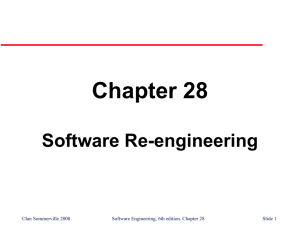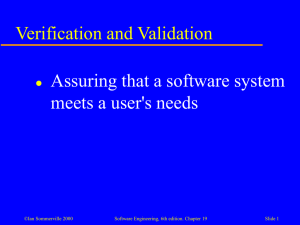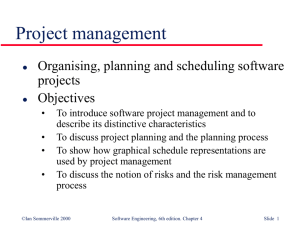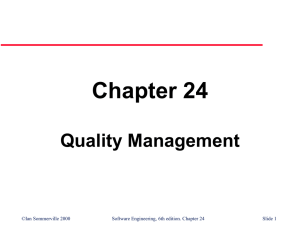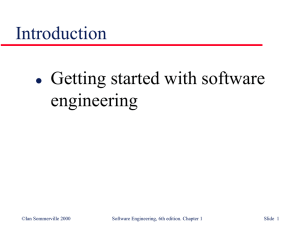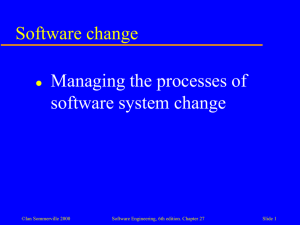Legacy Systems
advertisement
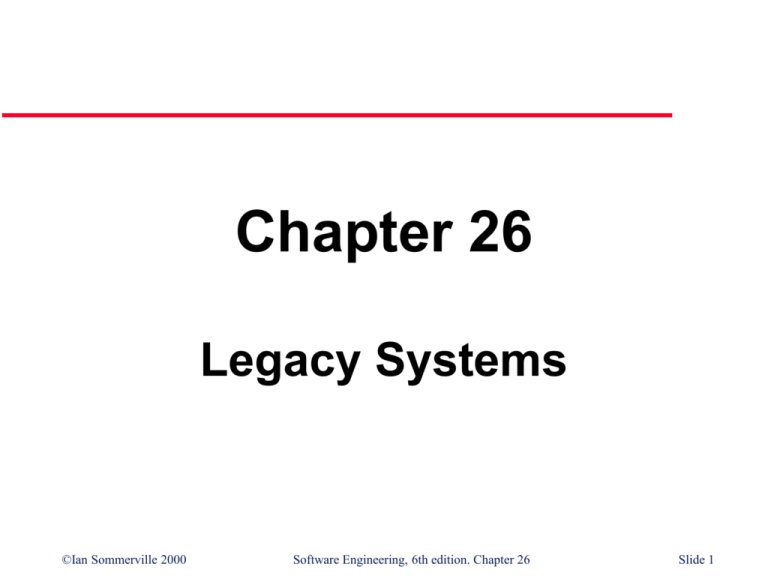
Chapter 26 Legacy Systems ©Ian Sommerville 2000 Software Engineering, 6th edition. Chapter 26 Slide 1 Input-process-output Input components read and validate data from a terminal or file Processing components carry out some transformations on that data Output components format and print the results of the computation Input, process and output can all be represented as functions with data ‘flowing’ between them ©Ian Sommerville 2000 Software Engineering, 6th edition. Chapter 26 Slide 2 Functional design process Data-flow design Structural decomposition Model the data processing in the system using data-flow diagrams Model how functions are decomposed to sub-functions using graphical structure charts that reflect the input/process/output structure Detailed design The functions in the design and their interfaces are described in detail. ©Ian Sommerville 2000 Software Engineering, 6th edition. Chapter 26 Slide 3 Data flow diagrams Show how an input data item is functionally transformed by a system into an output data item Are an integral part of many design methods and are supported by many CASE systems May be translated into either a sequential or parallel design. In a sequential design, processing elements are functions or procedures; in a parallel design, processing elements are tasks or processes ©Ian Sommerville 2000 Software Engineering, 6th edition. Chapter 26 Slide 4 Payroll system DFD ©Ian Sommerville 2000 Software Engineering, 6th edition. Chapter 26 Slide 5 Payroll batch processing The functions on the left of the DFD are input functions Read employee record, Read monthly pay data, Validate employee data The central function - Compute salary - carries out the processing The functions to the right are output functions Write tax transaction, Write pension data, Print payslip, Write bank transaction, Write social security data ©Ian Sommerville 2000 Software Engineering, 6th edition. Chapter 26 Slide 6 Transaction processing A ban ATM system is an example of a transaction processing system Transactions are stateless in that they do not rely on the result of previous transactions. Therefore, a functional approach is a natural way to implement transaction processing ©Ian Sommerville 2000 Software Engineering, 6th edition. Chapter 26 Slide 7 Design description of an ATM Using function-oriented design For some classes of system, such as some transaction processing systems, a functionoriented approach may be a better approach to design than an object-oriented approach Companies may have invested in CASE tools and methods for function-oriented design and may not wish to incur the costs and risks of moving to an object-oriented approach ©Ian Sommerville 2000 Software Engineering, 6th edition. Chapter 26 Slide 9 Legacy system assessment Organisations that rely on legacy systems must choose a strategy for evolving these systems Scrap the system completely and modify business processes so that it is no longer required Continue maintaining the system Transform the system by re-engineering to improve its maintainability Replace the system with a new system The strategy chosen should depend on the system quality and its business value ©Ian Sommerville 2000 Software Engineering, 6th edition. Chapter 26 Slide 10 System quality and business value ©Ian Sommerville 2000 Software Engineering, 6th edition. Chapter 26 Slide 11 Legacy system categories Low quality, low business value Low-quality, high-business value These make an important business contribution but are expensive to maintain. Should be re-engineered or replaced if a suitable system is available High-quality, low-business value These systems should be scrapped Replace with COTS, scrap completely or maintain High-quality, high business value Continue in operation using normal system maintenance ©Ian Sommerville 2000 Software Engineering, 6th edition. Chapter 26 Slide 12 Business value assessment Assessment should take different viewpoints into account System end-users Business customers Line managers IT managers Senior managers Interview different stakeholders and collate results ©Ian Sommerville 2000 Software Engineering, 6th edition. Chapter 26 Slide 13 System quality assessment Business process assessment Environment assessment How well does the business process support the current goals of the business? How effective is the system’s environment and how expensive is it to maintain Application assessment What is the quality of the application software system ©Ian Sommerville 2000 Software Engineering, 6th edition. Chapter 26 Slide 14 Business process assessment Use a viewpoint-oriented approach and seek answers from system stakeholders Is there a defined process model and is it followed? Do different parts of the organisation use different processes for the same function? How has the process been adapted? What are the relationships with other business processes and are these necessary? Is the process effectively supported by the legacy application software? ©Ian Sommerville 2000 Software Engineering, 6th edition. Chapter 26 Slide 15 Environment assessment ©Ian Sommerville 2000 Software Engineering, 6th edition. Chapter 26 Slide 16 Application assessment ©Ian Sommerville 2000 Software Engineering, 6th edition. Chapter 26 Slide 17 System measurement You may collect quantitative data to make an assessment of the quality of the application system The number of system change requests The number of different user interfaces used by the system The volume of data used by the system ©Ian Sommerville 2000 Software Engineering, 6th edition. Chapter 26 Slide 18 Key points A legacy system is an old system that still provides essential business services Legacy systems are not just application software but also include business processes, support software and hardware Most legacy systems are made up of several different programs and shared data A function-oriented approach has been used in the design of most legacy systems ©Ian Sommerville 2000 Software Engineering, 6th edition. Chapter 26 Slide 19 Key points The structure of legacy business systems normally follows an input-process-output model The business value of a system and its quality should be used to choose an evolution strategy The business value reflects the system’s effectiveness in supporting business goals System quality depends on business processes, the system’s environment and the application software ©Ian Sommerville 2000 Software Engineering, 6th edition. Chapter 26 Slide 20
